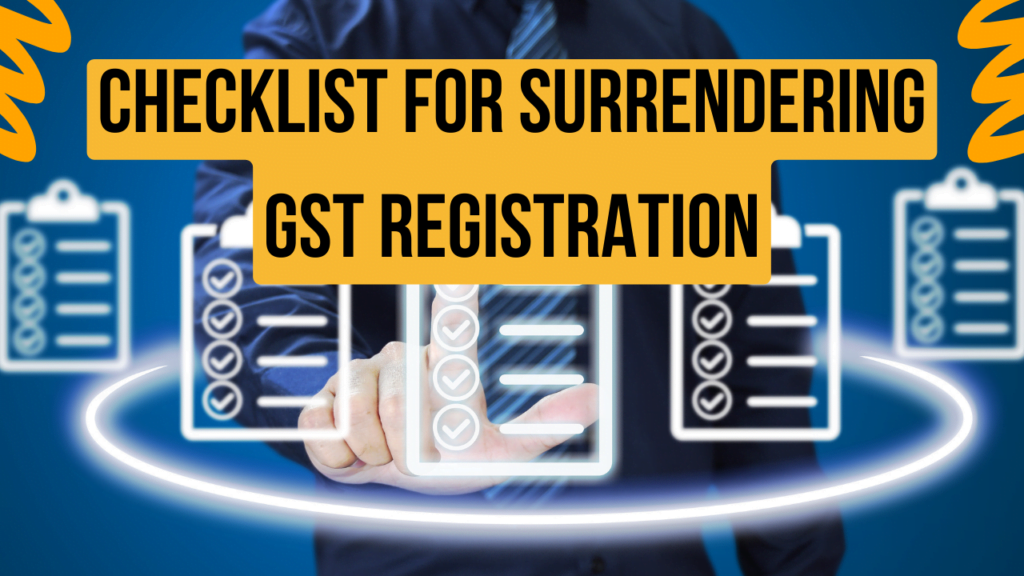In the fast-paced world of business, things like brief or lasting shutdowns can happen. If you have no business and the GST number is active, you are obliged to file GST returns and follow the related compliance.
So, what to do? It’s better for you to surrender the GST number and get out of the monthly stress of complying with taxation rules, and paying the auditor to file returns. This article talks about how to file GST returns and surrender it, when a business in India is closed or not doing business, so that you can avoid any further notice from the department.
Understanding GST Return Filing Requirements
Once you take a GST registration, it comes under the law of GST and liable to pay taxes and comply with rules and sections. The Act mandates the filing of GST returns by registered businesses.
The returns like GSTR-3B to avail credit and discharge the outward liability and GSTR-1 to declare the outward supplies of goods and services, helping the tax authorities assess the correct GST liability.
So, we divide the business activities into two scenarios: –
Active Businesses: Regular filing of GST returns (usually GSTR-3B and GSTR-1) is mandatory for businesses with taxable supplies.
Businesses with Zero Transactions: If your business is temporarily closed or has no taxable transactions during a tax period, you are still liable to file GST returns. You can simply file a Nil return (containing information but showing zero tax liability) to avoid any late fee or notice from the department. Non-filing of returns for more than 6 months, will result in suo-moto cancellation of the registration. If it gets canceled, you may file for revocation and will have to pay a late and applicable penalty.
Procedure to surrender GST registration
File All Returns: Ensure you file all returns (GSTR-3B) whether NIL or with taxable values, for all tax periods up to the closure date of your business.
Then, submit Form REG-16 online through the GST portal, intimating the authorities about your business closure. This form requires details like the closure date and reason for closure.
When the person who has submitted an application for cancellation of his registration is no longer liable to be registered or his registration is liable to be canceled, the Superintendent of Central Tax or Commercial tax officer will issue an order in FORM GST REG-19, within a period of thirty days from the date of application or, as the case may be, the date of the reply to the show cause issued, cancel the registration, with effect from a date to be determined by him and notify the taxable person, directing him to pay arrears of any tax, interest or penalty
Checklist for surrendering GST registration
I am sharing a checklist which every taxpayer needs to check before surrendering their registration. You can also hire experts because scenarios can vary. But, these points are essential to evaluate while surrendering GSTIN. Condition, You have filed all the GSTR-3B and GSTR-1 returns.

1. Reverse Input Tax Credit: Whatever input tax credit lying in your electronic credit ledger, and you don’t have any plan in near future to perform any business activity. You have to reverse the input tax credit before surrendering. You have to reverse only the balance credit after adjusting the tax liability in GSTR-3B returns.
2. Section 16(4): As per this section, you can avail the credit of the previous financial year up to 30th November of the subsequent year. For example, to avail credit for FY 2022-23 was due on 30th November 2023. If you file any financial year returns after the due date and avail credit in that and used to setoff liability, it becomes Ineligible credit and you have to reverse it along with interest. Therefore, you should wisely go through this provision before surrendering GSTIN.
3. Check E-way bill liability: If you are dealing with goods, you might be generating e-way bills. Analyze all e-way bills and check whether duty has been against those e-way bills or not. If you miss any payment against e-way bills, you may get notice even after the cancellation of GSTIN.
Returns to be filed while exiting from GST
A tax officer (Superintendent of Central Tax or Commercial tax officer) won’t simply accept your application for surrendering GST registration. Before applying for cancellation of GSTIN, you need to file all GSTR-3B and GSTR-1 returns with due interest payment or late fee, if any. You can pay dues through DRC-03, if any arises after scrutiny of the records by the tax officer.
You will need to reverse the idly available input tax credit available in the electronic credit ledger. and remember, you won’t get any refund on it on closure of business. There is no such provision for it. This also can be done through DRC-03 before filing Final Return (GSTR-10), if you are not filing any further GSTR-3B return. The conditions have been outlined in the Section 29 (5) of the CGST Act 2017.
File GSTR-10 within three months from the date of cancellation or date of cancellation order issued, whichever is later as per Rule 81 of the GST Rules. Check GSTR-10 return format.
You can file a nil GSTR-10 return if you don’t have any Input Tax Credit (ITC) in stocks, semi-finished goods, finished goods, capital goods or plant & machinery or no tax liability to pay.
Filing late GSTR-10 also attracts late fees, hence, it is recommended to file GSTR-10 within three months as the case may be.
Answer to your Query
Can you get your GST registration back? Yes, you can file revocation as per Section 30 of the CGST Act 2017. It can be filed within 30 days from the date of cancellation. Sometimes, the government extends the time limit for filing revocation applications. When you login on gst.gov.in portal, you will see the option to file for revocation else you will have to file an appeal before JC/ADC.
Can Tax-officer issue notice after cancellation? Yes, the tax officer has full power under the GST Act to recover any dues even from the canceled taxpayer or non-registered taxpayers. The officer can issue notice under Section 63, or Section 74 or Section 76 along with interest under Section 50 and penalty under Section 74 or Section 122 (as applicable).
Who no need to file GSTR-10 returns
This form is not required to be filed by taxpayers or persons who are registered as :-
- Input Service Distributors;
- Persons paying tax under section 10 (Composition taxpayer);
- Non-resident taxable person;
- Persons required to deduct tax at source under section 51; and
- Persons required to collect tax at source under section 52
Conclusion:
It can be very stressful, if you receive notice from the department at any stage. This gets aggravated when you receive notice of dues with interest and penalty even after the closure of business. This can increase your financial burden and paying to a lawyer, CA for the case also affects you financially.
I have listed out all the parameters, you can check these while closing your business and surrendering the GST Identification Number. This way you can definitely avoid any unnecessary notices from the department. By following the appropriate procedures, filing Nil returns when applicable, initiating cancellation when necessary, and filing final return GSTR-10, you can ensure GST compliance and avoid potential penalties.
Remember, seeking professional advice can provide valuable assistance in complying these regulations effectively, as you also understand each and every case is different and varies from business to business.
check our Financial Planning Tool for your Monthly Investment










1 Comment
View Comments